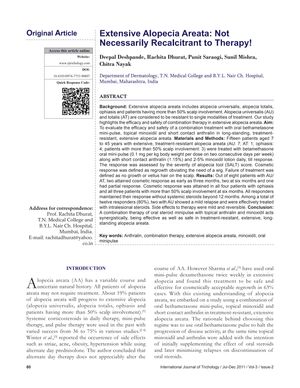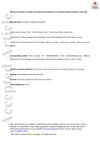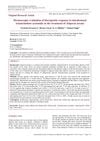Extensive Alopecia Areata: Not Necessarily Recalcitrant to Therapy
January 2011
in “
International Journal of Trichology
”

TLDR Some people with severe, long-lasting baldness responded well to a specific combination treatment.
Between 2008 and 2010, a study involving 15 patients with extensive, treatment-resistant alopecia areata tested a combination therapy of oral betamethasone mini-pulse, topical minoxidil, and short contact anthralin. The patients, aged 7 to 45, included various forms of alopecia, such as alopecia universalis (AU), alopecia totalis (AT), ophiasis, and those with significant scalp involvement. The effectiveness of the treatment was measured using the SALT score, aiming for a cosmetic response that would eliminate the need for a wig. Results indicated that 4 out of 8 patients with AU/AT achieved a cosmetic response within 3 to 6 months, with 1 additional patient showing partial response. All patients with ophiasis and those with more than 50% scalp involvement attained cosmetic response at 6 months. Overall, 80% of responders maintained their response for over 12 months without systemic steroids. Two AU patients had a mild relapse treated with intralesional steroids, and side effects were mild and reversible. The study concluded that the combination therapy was effective and safe for those with extensive, long-standing alopecia areata.
View this study on journals.lww.com →
Discuss this study in the Community →
Cited in this study
1 / results
research Treatment-resistant alopecia areata. Response to combination therapy with minoxidil plus anthralin
Using minoxidil and anthralin together can improve hair regrowth in severe alopecia areata patients who didn't respond to individual treatments.
Related
5 / resultsresearch Sisaipho Alopecia Areata Treated With Tofacitinib and Oral Minoxidil
Tofacitinib and oral minoxidil may help treat Sisaipho alopecia areata.

research Efficacy of Systemic Minoxidil and Tofacitinib Combination in Treatment-Resistant Alopecia Universalis
Using minoxidil and tofacitinib together can effectively treat severe hair loss.

research Dermoscopic Evaluation of Therapeutic Response to Intralesional Triamcinolone Acetonide in the Treatment of Alopecia Areata
Intralesional triamcinolone acetonide effectively treats alopecia areata, as shown by significant improvements in hair regrowth and dermoscopic indicators.

research Extensive Alopecia Areata: Not Necessarily Recalcitrant to Therapy
Some people with severe, long-lasting baldness responded well to a specific combination treatment.

research Treatments for Androgenetic Alopecia and Alopecia Areata
Minoxidil and finasteride treat hair loss; more research needed for other options.